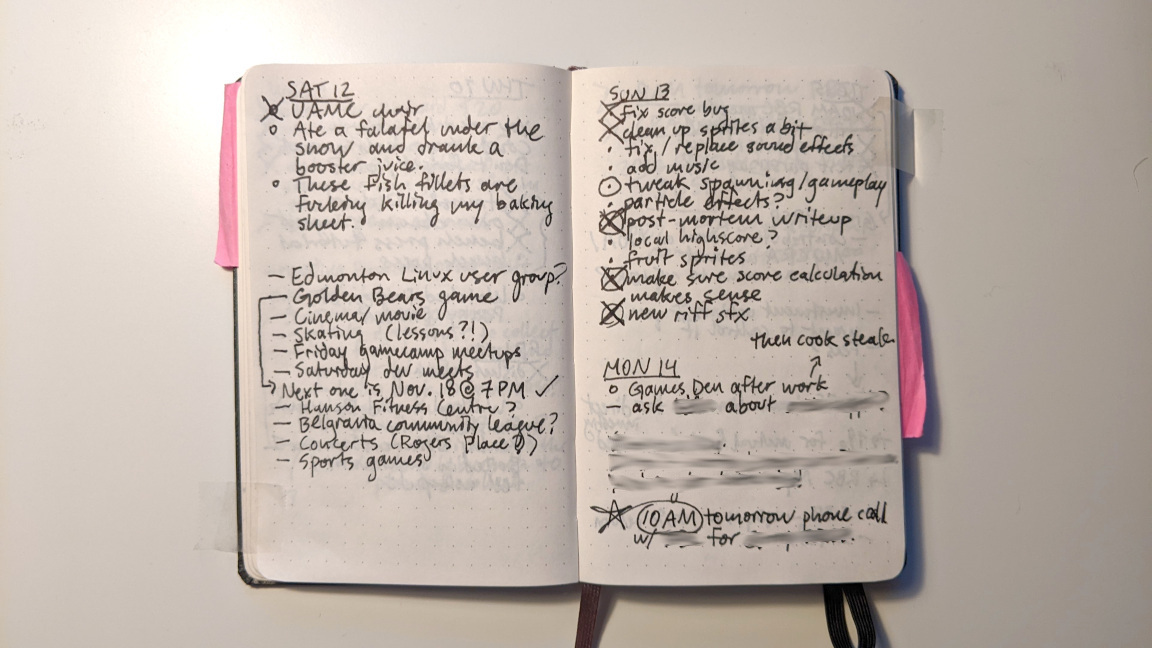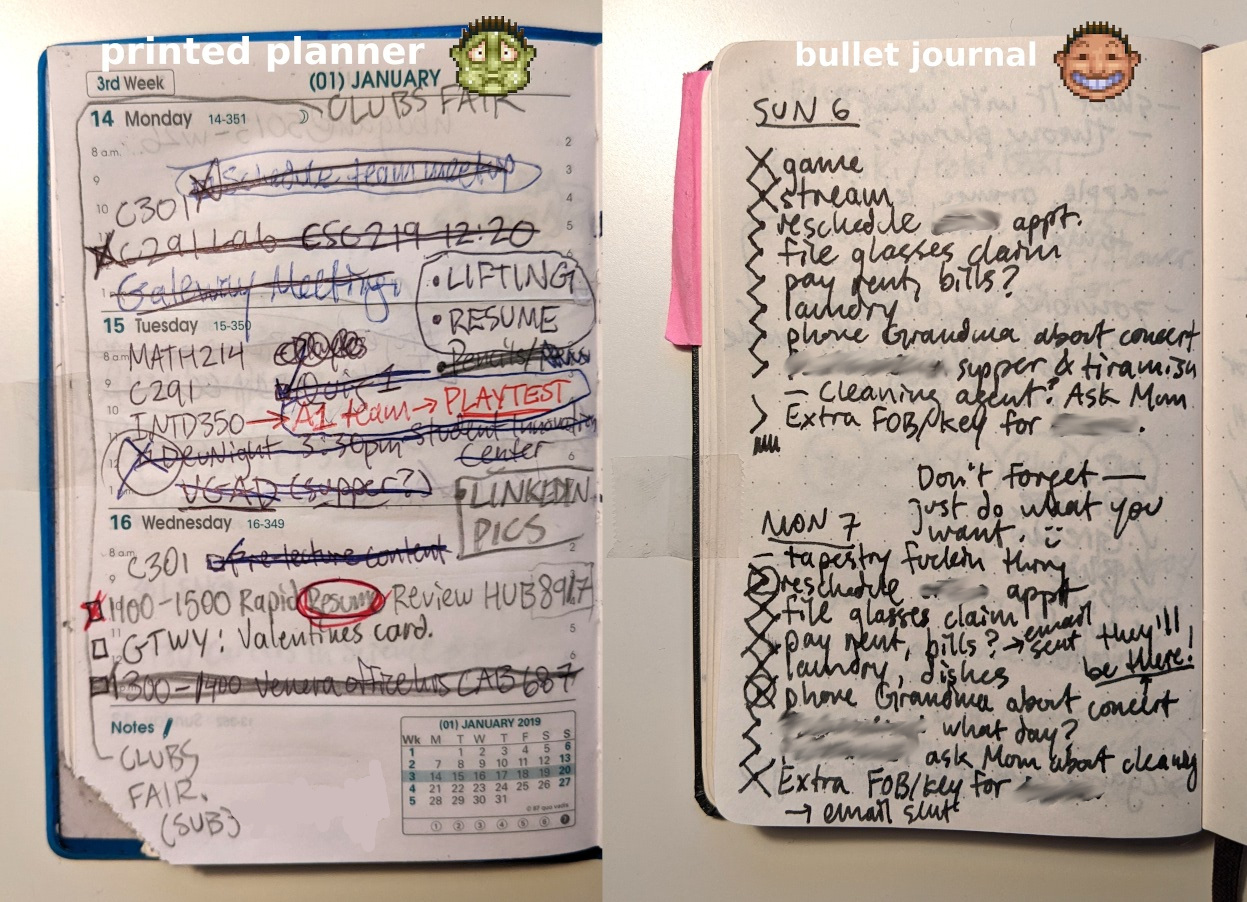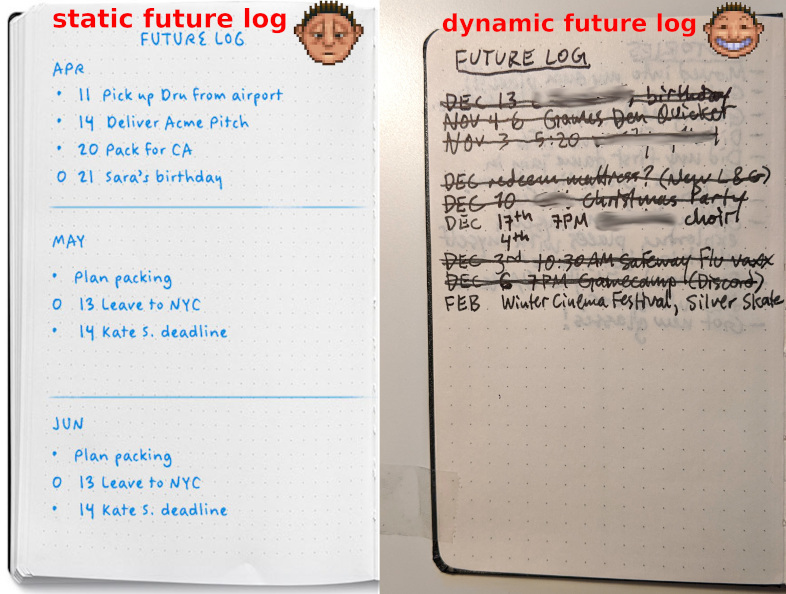Modding the bullet journal method
published 2022-12-06
last updated 2022-12-06

I've been using the bullet journal method to stay organized since 2019.
I used to use the generic printed planners that are sold at office supplies stores. My problem with printed planners is that they aren't flexible enough. When I have a busy day I may need an entire page, while for days where nothing happens the space is wasted.
The rolling nature of the bullet journal's Daily Log means that each day uses exactly as much space as it needs to. I never have to worry about running out of space, or writing something just to fill it up.

The reason this is so important is because any busywork or friction means death for an organizational system. My chief principle is to make my journal as easy as possible to use. I've made some slight modifications to the method with this in mind:
No index page or page numbers. What's the point? This isn't a textbook. This is my private notebook. Formal rituals like page numbers are just another chore; pointless for the way that my brain works. If I need to quickly flip to a page I can put a small sticky-note on it to act as a bookmark.

Bookmarks. I should be able to open the book to today's entry instantly. Any time spent flipping around is friction. Right now I'm using a Moleskine, which comes with a bookmark string. In previous journals I cut the bottom-right corner off of the pages to be able to instantly open it to the current day. That worked extremely well. I have sticky notes on the Future Log and the current Monthly Log, so I can flip to them.

A rolling Future Log. The original bullet journal method prescribes writing out sections for the months in the Future Log. I'm not sure why, since it is quite similar to the planners we are trying to escape from. So instead my Future Log is just a sheet of dates. Each row line item is a date; NOV 3 5:20 optometrist appt. , for example. Then when I migrate to a new month I just strike them out. Dates in different months mingle together. But at least there's no more static allocation of space.

A mini calendar in the Monthly Log. The original method's "column of dates" is an interesting way to experience a month, but again, you're limited to writing one or maybe two events for each date. My way is built to map many events to one date: draw a circle around the day and write the event below. Two events, two circles. Three events, three circles. Or underlines; whatever looks best. You get the idea.
The first page. Instead of an index, I use the first page to set the mood for my book-- a sort of keystone page upon which the foundation of my life is built. The first page of my current journal is a "Victories" page, where I record my small wins and gratitudes. In a past journal I put the poem "Invictus" on the first page. Personal values, mantras, affirmations, quotes, and manifestos would also go nicely here.
Journal like Leonardo Da Vinci. The notebooks of Leonardo were as eclectic as he was. He didn't care about what should or shouldn't go in his journal. He just put ink to paper. His notebooks are a smorgasbord of sketches, diagrams, plans, ideas, calculations, thoughts, feelings. These are all supposed to mix together in the Daily Log in one big soup. Don't police your own journal. Don't worry about organizing it; it doesn't matter. Just barf your brain right onto the page. Be free. You can always add another bookmark if you really need to. But chances are, the final artifact is not as valuable as the process of getting your thoughts out there.
Taking breaks from the neuroticism of planners is healthy. Because of this system's easy rigour, I find that I can take holidays from my journal when I need to, perhaps over a weekend every month or so, and come right back to it every time. Because there's no friction. It's not a chore. I find myself wanting to use it when it's time to get back on the horse.
The inventor of the bullet journal brand, Ryder Carroll, says the main advantage of the system is not its organizational properties, but its ability to make you more mindful. I can confirm that this is true. When you move a task forward for seven days in a row without doing it, you quickly become aquainted with what you actually do every day. So, tasks that aren't important after all are eventually struck off. Or, alternatively, I am repeatedly shown the important things that I neglect. To the extent of power that paper has, my journal helps me to do what really matters.
Sadly, it seems that in the meantime, bullet journaling has been taken over by the zeitgeist. If you've already heard of bullet journaling, it's probably in the context of an Instagram post of a watercolour art with 💅✨" October "✨💅 calligraphy. I call that scrapbooking. For the purposes of actually getting things done that artsy stuff is complete cowpie. For all that this post purports, you should be skeptical of techniques you see online. As soon as you start drawing static formats like "spreads", you're completely destroying the fluidity that gives this method its power. If you find yourself "laying out" your week, you might as well be using Google Calendar.

The sweet irony is that by following the philosophy I've laid out here you end up with a true artefact of your life at any particular time. It's more earnest, which makes it more beautiful than any perfectionist artsy "bullet journal" you'll find on the web.
Ultimately everyone should do what they have proven works for them. This is what works for me.
And no, it's not a diary, it's a JOURNAL! No wait, a LOG! Yeah! That sounds manly. Captain's log... supplemental...